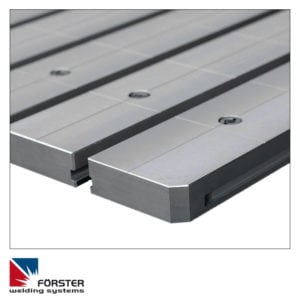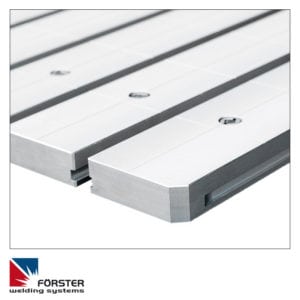Welding jobs involve the use of various types of metal and a number of different processes. While traditional welding tables were made of carbon steel, specialty welding tables are made of other metals including gray cast iron and various alloys that enable welders to achieve a professional finish.
The question though is, Which type of welding table should you use for specific projects?
Benefits of Gray Cast Iron Welding Tables
 There are various types of cast iron all of which are alloys of iron, carbon (usually between 1.7 and 4.5 percent), and silicon.
There are various types of cast iron all of which are alloys of iron, carbon (usually between 1.7 and 4.5 percent), and silicon.
Gray (or grey) iron is the most common form of cast iron. Also known as flake graphite because it contains many graphite flakes as well as perlite, it does not have good mechanical properties, and it is not an easy metal to weld using the metal arc-welding process unless the metal is preheated and the welding heat is controlled very carefully. It also has very low ductability and a low expansion point when the metal is exposed to any kind of heat.
The irony of this is that gray cast iron makes a really great surface for welding because the surface remains flat and welding spatter doesn’t stick to it. Since most welding processes result in some degree of spatter, it is an advantage to work on a welding table that is resistant to spatter.
As it ages, gray cast iron becomes increasingly resistant to the hot, molten bits of metal that spatter onto the work table surface during the welding process.
Benefits of Aluminum-Copper Alloy Welding Tables
 When welding with stainless steel the best results will be produced by working on non-ferritic surfaces that do not contain iron. Ferrous metal surfaces can result in scratches to the stainless steel work piece and sometimes even more severe pitting.
When welding with stainless steel the best results will be produced by working on non-ferritic surfaces that do not contain iron. Ferrous metal surfaces can result in scratches to the stainless steel work piece and sometimes even more severe pitting.
By separating a stainless steel work piece from any type of ferritic material you are already well on the way towards a more professional finish. An aluminum-copper (AL/Cu) alloy surface has a high tensile strength, but this is combined with low surface hardness and high thermal conductivity which is also ideal in terms of spatter-resistance.
What Else Makes a Great Welding Table?
While the metal used for a welding table is hugely important, so too is the design of the table itself.
Foster America specializes in modular 3D welding tables that can be adjusted to accommodate a variety of components that can be used to create custom solutions for welding. The most exciting concept is so simple you’ll be pinching yourself, wondering why other systems don’t offer the same options. Forster America tables have rails that are spaced 100 mm apart and can be moved to accommodate jigs and other fixtures. This helps immensely during all those initial processes like measuring dimensions and angles, and is invaluable when you have to correct, re-align, and mechanically rework sections.
If you want something really great that offers a completely custom solution for your welding operation, call Forster America to see how we can help.

